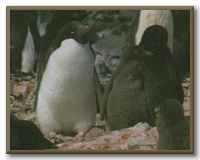The Penguins (order Sphenisciformes) are the best known, and most numerous of all Antarctica's birds. Their combined biomass accounts for about 85 per cent of the biomass of all the Antarctic birds, of which over half is Adelie penguins. Penguins are stocky, flightless birds with wings reduced to flippers with which they propel themselves through the water. On land they walk upright with a waddling gait or in short hops.
Most penguins stand 60 to 70cm high but the largest, the Emperor Penguin, stands waist high (about 1m) and weighs up to 41kg. They nest in large dense colonies with some containing 80,000 or more birds. The sight, smell and noise of any colony are unforgettable. Most build nests of stones and in them incubate one or two eggs.
|
|
|
Common characteristics of penguins: Adelie penguins can swim very quickly-up to 15 kilometers per hour. This gives them the momentum to leap out of the water onto the shore or ice floes. (You can see some Emperors "flying"-after all, they are birds!) up out of the ocean in the "Rancho Penguino" sequence in program 4.) They can leap up to 2 meters, which is also a useful way to escape from predatory leopard seals. Other ocean predators are killer whales and on land their main predator is the skua, a bird which takes both eggs and chicks.
|
|
WANT TO LEARN MORE?
|
|
Websites
• Antarctic Penguins Images, basic information and the sounds of penguins. • Waddling is a good way to make up for short legs Press release explaining that scientists have discovered that the penquin waddle helps the animal save energy. • Life at Sea: At Home in the Ocean Basic information on penquins, their life at sea, blackfooted penguins in peril and an FAQ on penguins. • Nature: The World of Penguins Information about penguins, how to protect them and how they are so graceful in water. • Pete and Barbara's Penguin Pages Information on penguins including their life cycle, how they are threatened and where to see them. • Antarctic Biology General information on the animals of Antarctica including krill, fish, birds, penguins and seals. • Penguins Basic information on penguins. |
![]()

